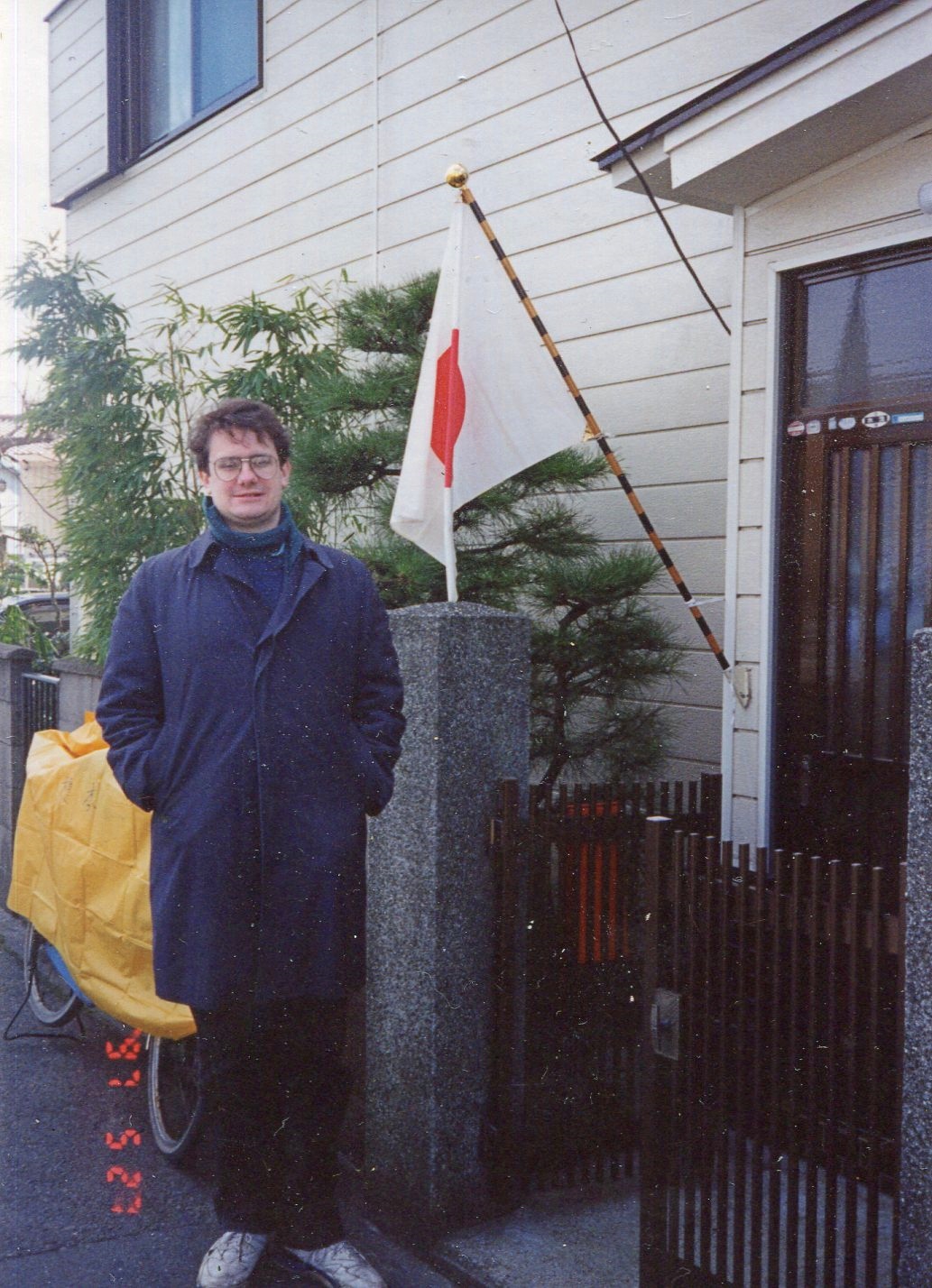Among our collection of physical prints, most of them pre-2005 or so, is this image.
I’m standing in front of my in-laws’ house on January 1, 1994 (one feature of the camera was to imprint the date, but for whatever reason, it is wrong on this print). I spent most of winter break there. Much of the time I was in their kitchen, the warmest room in the house, where I read War and Peace. My in-laws considered this slightly peculiar, but not so much that I didn’t hear about it until much later.
Forward almost 30 years and we found ourselves in Louisville. We arrived late on Wednesday, actually past midnight on Thursday, late enough that the night clerk at our hotel was the only person around when we got there. He had been putting together a model figure from a kit before we arrived. Some pieces were arrayed on the desk near him, but he was mostly finished. Yuriko recognized it: an action hero from an anime, something I would have never recognized.
“I got it for Christmas,” the clerk, a large young man with a large beard and collection of pimples, told us when Yuriko mentioned that she recognized it. “He’s my favorite.”
“Helps pass the time on the night shift?” I said. He agreed that it did.
Otherwise it was a standard check-in process, but the momentary interaction made the experience more memorable. The property was part of a behemoth hospitality outfit, and if the company had any imagination (such companies seldom do), it would instruct its clerks to have some kind of conversation-piece project at hand that would engage more curious patrons. You know, to build the brand by associating a mildly memorable and pleasant experience with the place one stays.
Maybe that isn’t such a good idea. Such a company could be counted on to mandate their clerks detail in reports the interactions thus generated – fill up that spreadsheet, tick those boxes, remember that documenting the process is as important as the results – and press them to meet some sort of quota of being memorable to their customers.
Thursday was the first of three full days in northern Kentucky, returning on New Year’s Eve. Rather than venture somewhere by plane this year — with last year’s dud in mind — we opted for a drive. As long as no blizzard was forecast, we’d be good to go. Head somewhere to the south. We focused on Louisville because it occurred to me in November that I hadn’t spent much time there in more than 30 years, since my visits to attend the Kentucky Derby in the late ’80s, and Yuriko had never spent any time there.
Since then, I’d also heard it on good authority, namely from someone who used to live there, that Louisville is a city of distinctly interesting neighborhoods, perhaps more than you’d expect from a metro its size (1.3 million). Something like Nashville, though that metro is larger. In fact some similarities with Nashville are fairly close, such the downtown street grid that, away from downtown, soon devolves into as non-grid as a pattern of streets can be, wandering this way and that at odd angles through hilly territory, and changing names without warning.
We first encountered Crescent Hill, a well-to-do neighborhood east of downtown, stopping for a few minutes to look in a few of the shops of Frankfort Avenue. I’ve read that the area was formerly known as Beargrass, after a nearby creek. A name the area should have kept, if you asked me.
Included are the sorts of places well-to-do neighborhoods support, such as Urban Kitty Consignment Boutique, Wheelhouse Art, Era Salon, Eggs Over Frankfort, Carmichael’s Bookstore and Margaret’s Fine Consignments. Temps were maybe 10 degrees warmer than at home, so not bad for a short stroll.


The imposing Crescent Hill Baptist Church is on Frankfort Ave. Closed.
The local library was open, so we went in.
Inside was a table with books for sale, and I picked up a paperback for $1 entitled The Taste of Conquest: The Rise and Fall of the Three Great Cities of Spice by Michael Krondl (2008). The cities in question are Venice, Lisbon, and Amsterdam. I started reading that night and it’s good. He brings up a few interesting points right away, such as that the hoary old explanation about the medieval use of spices, namely that they covered up rot, is nonsense.
“But what if the meat were rancid?” Krondl asks rhetorically. “Would not a shower of pepper and cloves make rotten meat palatable? Well, perhaps to a starved peasant who could leave no scrap unused, but not to society’s elite. If you could afford fancy, exotic seasonings, you could certainly afford fresh meat.”
From Crescent Hill it’s a short pop over to the Louisville Water Tower, including a short drive on Zorn Avenue, which instantly became my favorite street name in Louisville.
For a bit of water infrastructure, it’s impressive, rising 185 feet over the banks of the Ohio River and dating from 1860. And still in use. It’s also being renovated, so we couldn’t get that close.

In its own way, the nearby smokestack – I took it to be a smokestack – is just as impressive.

Note the iron ladder rising up the side of the stack. Note also that its bottom section is missing. Removed, I bet, after one too many moron teenage boys decided to take a climb, sometimes resulting in a sudden and shattering loss of their youthful health and vim.